 When we study the ancient world, we have but one sense to use. We can, unfortunately, only view the past with our eyes. As beautiful as the artefacts of our ancestors are, this one dimensional perspective tends to be somewhat restrictive to our understanding. After all, when we consider our contemporary world, we have the benefit of seeing, smelling and hearing all of the various elements that make up that landscape. Not so with the ancient world.
When we study the ancient world, we have but one sense to use. We can, unfortunately, only view the past with our eyes. As beautiful as the artefacts of our ancestors are, this one dimensional perspective tends to be somewhat restrictive to our understanding. After all, when we consider our contemporary world, we have the benefit of seeing, smelling and hearing all of the various elements that make up that landscape. Not so with the ancient world.
However there are a select few people trying to change that. Those people are working in the field of archaeoacoustics, and though this is a relatively new field of study, great strides are being made in an effort to understand the significance of sound as it pertains to the monuments and rituals of our ancestors. The term archaeoacoustics has been coopted from its earlier use, as it pertained to sounds being recorded in clay pottery and other such objects during their manufacture in ancient societies, so as to be “played back” with the use of modern equipment. This idea was once supported by many in mainstream science, but has recently fallen into disrepute as a result of many failed attempts to verify it through experiment. The term now relates more widely to the study of sound in ancient construction and monuments.
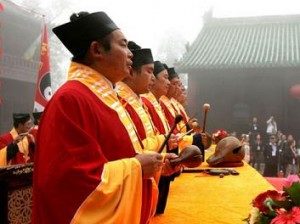
Daoist Monks chanting in ritual
In spite of the fanciful ideas of the more conspiratorial among us, not every ancient monument was constructed to capitalise on resonant frequencies, but some were and they deserve a closer look.
Chanting, a ritualistic form of stylised speech, and the root of all western music, was first used by ancient and prehistoric spiritual leaders in nearly all cultures as a means of furthering or supporting other aspects of ritual. It was meant to bring the participant closer to a religious or spiritual awakening. Chants are used in nearly all religious variants, from modern shamanistic cultures to pagan, Christian, Hindu, Buddhist, and Islamic traditions. It ranges from simple melodies to complex musical structures and depending on the setting, can offer a profound experience to witnesses.
As is common knowledge, sound or music has a profound effect on us humans (and likely on some animals as well). We develop strong associations between musical elements and certain emotions and our moods are often deeply affected by what we hear. For this reason, spiritual or religious chants often have a deep effect on our perception of related experiences. Religious hymns are designed to foster a connection between the congregant and the clergy, and in fact churches the world over are constructed with this in mind. The shape and orientation of the church and its internal elements are painstakingly arranged to optimise the acoustical properties of the space, so as to maximise the effect of song and instrument alike. And this is by no means a new practise.
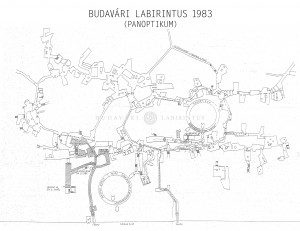
An antique map of the Labyrinth of Buda Castle (hi-res)
Nowhere is acoustical significance in ancient construction more striking than in underground temples. There are famous examples of such construction throughout the old world, perhaps the most famous is the King’s Chamber in the Great Pyramid of Khufu (or Cheops, whichever you prefer) at Giza in Egypt. Some theorists maintain that the King’s Chamber was designed and built to use sound as a resonant booster, to give the Pharaoh a better chance of reaching the afterlife, though this is not a widely held opinion among mainstream archaeologists or Egyptologists. Those same theorists, conspiracy theorists you might say, suggest also that the Hall of Records, an unconfirmed structure or room situated under the Sphinx, has significant acoustical properties as well. This is, for obvious reasons, entirely suppositional of course.
But we needn’t resort to conspiratorial fantasy in this case, for there are many ancient monuments and temples that use sound and acoustical properties to their advantage. The underground city complex at Budapest, called the Labyrinth of Buda Castle, which is located under Castle Hill in Buda (which is the west-bank part of Budapest on the Danube river in Hungary), is said to have special acoustical properties, though since this site is largely a natural formation, it doesn’t really count here. It does remain the oldest known example of the shape of a room or cave being used to amplify or resonate sound for ritual purposes.
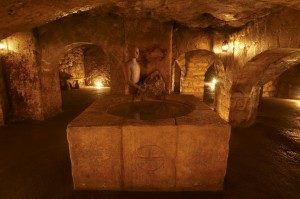
The Baptismal Font at Castle Hill
Other examples, such as the Oracle Room in the Hypogeum of Ħal Seflieni in Paola, Malta (Greece) offer much to study. Hypogeum means ‘underground’ in Greek, and in this case refers to a subterranean labyrinthine structure of the Seflieni phase of Maltese prehistory (3000-2500BC). It consists of several passages and chambers, of which the Oracle room is the smallest. With its delicately painted ceiling, the Oracle room boasts the most powerful or effectual resonant chamber in the ancient world. Even muted sounds made in this chamber resonate and amplify, which has the effect of distorting the sound and making it seem like it has a divine origin (or that it hadn’t been generated by any source in the chamber). Today the hypogeum is a necropolis, containing the remains of some 7000 prehistoric Greeks, but at one time it was used for religious ritual.
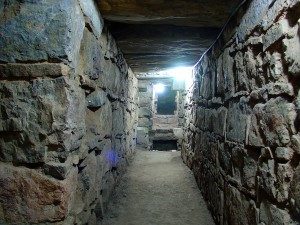
An intact corridor at Chavin de Huantar
Another site, Chavín de Huantar in the Peruvian Andes, is a large city ruin that was built by the pre-Incan culture known as the Chavín in approximately 1200BC, though the area is thought to have been occupied as early as 3000BC. The site has buildings, ruins, temples and other artefacts.
Ancient visitors and priests at Chavín de Huantar would have been privy to an experience not found anywhere else. The buildings were constructed using a highly specialized combination of shafts, corridors and surfaces, all designed to make a series of echo chambers, in which sounds – often conch shell trumpets, called pututus, being blown by priests outside of the structure and chanting, as well as water running in streams under and around the buildings – would seem otherworldly.[1] Add in the psychotropic effect of ritual consumption of San Pedro cactus juice (and possibly other substances, like ayahuasca), and one can easily see how a pilgrimage to such a temple would have been a profound spiritual experience.
Perhaps the first archaeoacoustic researcher, Iegor Reznikoff, an anthropologist of sound with the Université Paris Ouest, found, in the 1980’s, that there is a connection between the location of prehistoric artwork in the caves at Lascaux (and other ancient cave sites in southern France, where the oldest known human art is found from 25,000BC) and the acoustic resonance of those same locations.[2] Reznikoff and a colleague mapped such caves, highlighting areas of acoustical significance and found that those areas coincided with areas that held the most works of prehistoric art.[3] Which suggests a defined ritualistic process to the painting, and may have been prevalent among prehistoric artists.
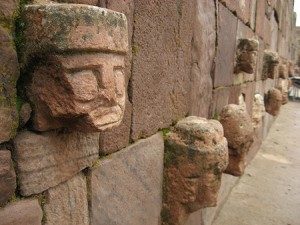
Anthropomorphic carvings at Chavin de Huantar
Acoustic resonance is a feature of many natural caves, and it’s likely that this natural feature was the primary motivator in the development of acoustics in ritual sites and practices. Modern technology allows archaeologists to identify and study such features of ancient sites, and in most cases the research is inaccessible to the amateur. However, there are branches of this endeavour that are within reach of anyone who can get themselves to the locations in question.
Recently, a team of researchers have been using sound to study the world famous Stonehenge megalithic site in Wiltshire, England. According to experts from London’s Royal College of Art, Stonehenge holds more mystery than meets the eye. For many years, enthusiasts and researchers have held that Stonehenge had an audio component, either in its use or construction. Many visitors report that chants and music seem to resonate in a strange way at various points within and around the structure, but new insights seem to suggest that the stones themselves were musical instruments.
Research recently published in the Journal of Time & Mind, suggests that the bluestones – the smaller stones that make up the interior of the monument – actually have acoustical properties and may have been selected for that reason.[4] It turns out that the stones resonate in a peculiar way when struck with a hammer or other instrument, and generate a wide range of sounds. Researchers even found what may be evidence of hammer or stone strikes on several of the stones, indicating that they’re on the right track.
This research, with the input of other experts, suggests that many of the standing stone sites throughout the UK may have had, as a central feature, an acoustic nature.[5] It may be that Stonehenge and other standing stone circles and like monuments were built as musical instruments, to be used in conjunction with or as a part of ritualistic gatherings and celebrations.
The same may be true for monuments all over the world, as is highlighted by researchers such as Michael Tellinger, who demonstrates in a video on his YouTube channel the acoustic properties of artefacts found at Waterval Boven, South Africa. (See below)
There is no denying it, sound has played a central role in the development of not only human spirituality and culture, but also in architecture. While most of our history can only be relayed in terms of visual artefacts and writing, the aural history of our ancestors just begs to be heard. And when you consider the fact that resonant sound has been a significant part of human life for upwards of 27,000 years (at least), it’s no wonder so many people feel so passionately about music and its makers.
[1] Brooks, Michael. Was sound the secret weapon of the Andean elites? Newscientist Magazine – September 2008 http://www.newscientist.com/article/mg19926721.700-was-sound-the-secret-weapon-of-the-andean-elites.html?page=1
[2] Starr, Douglas. Notes From Earth: Echoes From The Distant Past. Discover Magazine – November 2012 http://discovermagazine.com/2012/nov/03-echoes-from-the-distant-past#.UsCjmvRDsid
[3] American Institute of Physics. “Music Went With Cave Art In Prehistoric Caves.” ScienceDaily, 5 Jul. 2008. Web. 29 Dec. 2013. http://www.sciencedaily.com/releases/2008/07/080704130439.htm
[4] Paul Devereux, Jon Wozencroft. Stone Age Eyes and Ears: A Visual and Acoustic Pilot Study of Carn Menyn, Environs, Preseli, Wales. Time & Mind http://www.tandfonline.com/doi/full/10.1080/1751696X.2013.860278#.UsCuvfRDsie
[5] Sarah Griffiths, Amanda Williams. Stonehenge ‘was a prehistoric center for rock music’: Stones sound like bells, drums and gongs when played. DailyMailUK December2013 http://www.dailymail.co.uk/sciencetech/article-2515159/Why-Stonehenge-prehistoric-centre-rock-music-Stones-sound-like-bells-drums-gongs-played.html



 A great rumble breaks the silence of an early morning sunrise as the Earth’s crust heaves and cracks. Buildings creak and sway, windows break, furniture collapses and people begin to take cover. It’s an Earthquake, and it’s a common experience in some parts of the world. While Earthquakes can strike literally anywhere on Earth, there are places that are prone to a great deal more tectonic activity than others, and in the wake of the terrible tragedy in Japan this spring, one cannot help but conjure images of death and destruction.
A great rumble breaks the silence of an early morning sunrise as the Earth’s crust heaves and cracks. Buildings creak and sway, windows break, furniture collapses and people begin to take cover. It’s an Earthquake, and it’s a common experience in some parts of the world. While Earthquakes can strike literally anywhere on Earth, there are places that are prone to a great deal more tectonic activity than others, and in the wake of the terrible tragedy in Japan this spring, one cannot help but conjure images of death and destruction.
 Conspiracy theorists are now grabbing hold of the idea, especially in the wake of reports that earthquake lights were seen just prior to the recent Japan earthquake and tsunami, and are suggesting that there is a sinister plot involved. For years now, conspiracy theorists have been blaming the High Frequency Active Auroral Research Program or HAARP for a host of natural disasters and other phenomenon, and one can’t help but draw a line connecting the idea of earthquake light and HAARP, though seeing a possible connection is only one part of the puzzle.
Conspiracy theorists are now grabbing hold of the idea, especially in the wake of reports that earthquake lights were seen just prior to the recent Japan earthquake and tsunami, and are suggesting that there is a sinister plot involved. For years now, conspiracy theorists have been blaming the High Frequency Active Auroral Research Program or HAARP for a host of natural disasters and other phenomenon, and one can’t help but draw a line connecting the idea of earthquake light and HAARP, though seeing a possible connection is only one part of the puzzle.




 Please, please, please, let 2014 be the year of reason, of critical thinking and common sense.
Please, please, please, let 2014 be the year of reason, of critical thinking and common sense.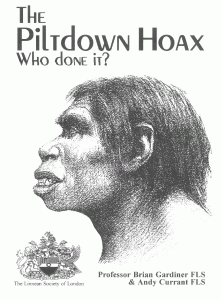 When you consider some classical hoaxes, from the Piltdown Man, or Orson Wells’ War of Worlds radio show, there seem to be obvious motivators that the perpetrators clung to in their planning and execution. Whether malicious in nature or purely innocent, these scenarios have typically been born of a desire to make the punch line stick. Of the two examples given above, whomever the hoaxer of the Piltdown bone fragments actually was, it seems clear that the intention was to ridicule and embarrass the paleontological scholars involved in examining the found materials. Orson Wells however, had innocent intentions; he simply wanted to entertain and, perhaps, took his good humour a little far (though some suggest that the real hoax is that the ensuing panic never actually happened, or is that yet another hoax?). In the end though, in both cases the purpose seems to have been to get a good laugh on the part of the hoaxer.
When you consider some classical hoaxes, from the Piltdown Man, or Orson Wells’ War of Worlds radio show, there seem to be obvious motivators that the perpetrators clung to in their planning and execution. Whether malicious in nature or purely innocent, these scenarios have typically been born of a desire to make the punch line stick. Of the two examples given above, whomever the hoaxer of the Piltdown bone fragments actually was, it seems clear that the intention was to ridicule and embarrass the paleontological scholars involved in examining the found materials. Orson Wells however, had innocent intentions; he simply wanted to entertain and, perhaps, took his good humour a little far (though some suggest that the real hoax is that the ensuing panic never actually happened, or is that yet another hoax?). In the end though, in both cases the purpose seems to have been to get a good laugh on the part of the hoaxer. 2009’s Balloon Boy hoax is a good example of a hoax that not only went too far, but also defies any attempt to reason through their motivations. Why do what they did? The obvious answer is to achieve that 15 minutes of fame to which we’re each entitled. But is that hollow recognition really the primary motivator for hoaxing?
2009’s Balloon Boy hoax is a good example of a hoax that not only went too far, but also defies any attempt to reason through their motivations. Why do what they did? The obvious answer is to achieve that 15 minutes of fame to which we’re each entitled. But is that hollow recognition really the primary motivator for hoaxing? Feldman says that in his study 60 percent of participants lied at least once during a 10 minute conversation. The majority of participants, denied having said anything untruthful, and were genuinely surprised when video footage was replayed. Feldman says that lying is, at this level, a subconscious reflex used to maintain self-esteem, not only from the perspective of others but from themselves as well.
Feldman says that in his study 60 percent of participants lied at least once during a 10 minute conversation. The majority of participants, denied having said anything untruthful, and were genuinely surprised when video footage was replayed. Feldman says that lying is, at this level, a subconscious reflex used to maintain self-esteem, not only from the perspective of others but from themselves as well. Ultimately, from this list, it would have to be that they’re attempting to boost their own self-esteem, but I would suggest that this list is inadequate to answer our question. It certainly seems like, with most hoaxes, that the people involved are trying to bolster their own self-esteem by lording such falsities over the heads of the public, at least those in the public who entertain such things, so as to feel superior to those who weren’t capable of “seeing the truth” as it were. It seems more than a lie, it seems a manipulation of people’s beliefs and fears in some cases. It seems a feature of the anti-establishment movement and a method for pushing misinformation into the discussion for the purpose of derailing productive discourse. It seems political and self-serving and deleterious, and if we look at individual hoaxes, we can see elements of all of the above, but it doesn’t seem like any of them can be considered the one true culprit.
Ultimately, from this list, it would have to be that they’re attempting to boost their own self-esteem, but I would suggest that this list is inadequate to answer our question. It certainly seems like, with most hoaxes, that the people involved are trying to bolster their own self-esteem by lording such falsities over the heads of the public, at least those in the public who entertain such things, so as to feel superior to those who weren’t capable of “seeing the truth” as it were. It seems more than a lie, it seems a manipulation of people’s beliefs and fears in some cases. It seems a feature of the anti-establishment movement and a method for pushing misinformation into the discussion for the purpose of derailing productive discourse. It seems political and self-serving and deleterious, and if we look at individual hoaxes, we can see elements of all of the above, but it doesn’t seem like any of them can be considered the one true culprit. Anyone who knows me, or perhaps who is a regular reader, knows that I have an affinity for big hairy hominids. Well, actually, I should probably clarify, there’s one particular big hairy hominid that I have in mind, not just dudes with a lot of back hair. I’m referring to Bigfoot, or Sasquatch if you prefer.
Anyone who knows me, or perhaps who is a regular reader, knows that I have an affinity for big hairy hominids. Well, actually, I should probably clarify, there’s one particular big hairy hominid that I have in mind, not just dudes with a lot of back hair. I’m referring to Bigfoot, or Sasquatch if you prefer. In that vein, I tuned in to Spike TV’s newest reality show last night, the 10 Million Dollar Bigfoot Bounty, starring Dean Cain. This show has been hyped in style over the last several weeks, especially among Bigfooters and their associated blogs and online communities, of which I am not necessarily a member. It had been promised that it would be a serious effort to find talented people, who are, after all is said and done, more likely than most to actually find that elusive evidence of Sasquatch. We’ve been promised that the cast and producers will take a pointedly scientific tact and that the whole thing will be treated as a scientific endeavour, rather than a TV spectacle.
In that vein, I tuned in to Spike TV’s newest reality show last night, the 10 Million Dollar Bigfoot Bounty, starring Dean Cain. This show has been hyped in style over the last several weeks, especially among Bigfooters and their associated blogs and online communities, of which I am not necessarily a member. It had been promised that it would be a serious effort to find talented people, who are, after all is said and done, more likely than most to actually find that elusive evidence of Sasquatch. We’ve been promised that the cast and producers will take a pointedly scientific tact and that the whole thing will be treated as a scientific endeavour, rather than a TV spectacle.


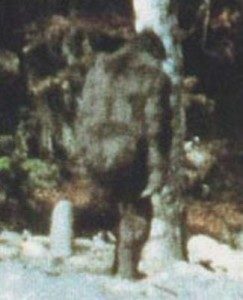 I suppose this is all part of the TV hook though, it gets the viewer riled up and passionate about the contestants and the show, and keeps them coming back for more.
I suppose this is all part of the TV hook though, it gets the viewer riled up and passionate about the contestants and the show, and keeps them coming back for more.
 Some particularly gruesome incarnations of the alien invasion scenario have flooded our movie theatres of late, though this is nothing new. Hollywood and by extension, western culture, has been obsessed with the subject of violent contact with extraterrestrials for decades. Even before the advent of moving pictures on the silver screen Orson Welles presented his listening audience with a fright they never forgot, in his adaptation of H.G. Wells’ classic novel The War of the Worlds. One thing Hollywood has made clear is their caricature of humanities fear of visitation from another world.
Some particularly gruesome incarnations of the alien invasion scenario have flooded our movie theatres of late, though this is nothing new. Hollywood and by extension, western culture, has been obsessed with the subject of violent contact with extraterrestrials for decades. Even before the advent of moving pictures on the silver screen Orson Welles presented his listening audience with a fright they never forgot, in his adaptation of H.G. Wells’ classic novel The War of the Worlds. One thing Hollywood has made clear is their caricature of humanities fear of visitation from another world. Even in-so-far as there are those among us who are unable or unwilling to discern between the truths of fiction and the falsities of reality, many have speculated on just what form such a visitation might take. Ultimately such speculation becomes a prediction (however un-provable) about not only the existence of, but the nature of extraterrestrial life in the universe. The sciences of Astronomy and Cosmology and Theoretical Physics have given us glimpses of what may be elsewhere in the cosmos. They speak of the probability of organic life being spread throughout our galaxy and beyond. They speak of the likely development of such life and the best-case chances of such life developing to some point that we might call it intelligent. And in fact the learned men, such as Stephen Hawking, Carl Sagan, Brian Green, Chris Impey, may be the best theoretical chance we have of defining exactly what or who we might face in the deep, dark void of space.
Even in-so-far as there are those among us who are unable or unwilling to discern between the truths of fiction and the falsities of reality, many have speculated on just what form such a visitation might take. Ultimately such speculation becomes a prediction (however un-provable) about not only the existence of, but the nature of extraterrestrial life in the universe. The sciences of Astronomy and Cosmology and Theoretical Physics have given us glimpses of what may be elsewhere in the cosmos. They speak of the probability of organic life being spread throughout our galaxy and beyond. They speak of the likely development of such life and the best-case chances of such life developing to some point that we might call it intelligent. And in fact the learned men, such as Stephen Hawking, Carl Sagan, Brian Green, Chris Impey, may be the best theoretical chance we have of defining exactly what or who we might face in the deep, dark void of space.

 Further, it would be entirely conceivable that such alien visitors could have evolved apparatus and biological processes for uses that we would find truly alien. In this vein one can imagine many such mechanisms: something equivalent to the mysterious human psi abilities, or rapid regeneration, and even the emission of plasmatic or acrid or totally unimaginable materials….just to name a few. Though as has been presented in recent films, any special abilities that our visiting aliens might possess, would be entirely incidental and any negative effect that they might have on Earth’s biology would be coincidental at best. As will be discussed later, it is inconceivable that an alien race could specifically evolve abilities that are specially adapted to aid or hinder human physiology, since our physiology would have had no impact whatsoever on the process of natural selection on their world.
Further, it would be entirely conceivable that such alien visitors could have evolved apparatus and biological processes for uses that we would find truly alien. In this vein one can imagine many such mechanisms: something equivalent to the mysterious human psi abilities, or rapid regeneration, and even the emission of plasmatic or acrid or totally unimaginable materials….just to name a few. Though as has been presented in recent films, any special abilities that our visiting aliens might possess, would be entirely incidental and any negative effect that they might have on Earth’s biology would be coincidental at best. As will be discussed later, it is inconceivable that an alien race could specifically evolve abilities that are specially adapted to aid or hinder human physiology, since our physiology would have had no impact whatsoever on the process of natural selection on their world.
 An extraterrestrial however, could not necessarily be said to be sustained by light and its derivatives as we are. Though if an alien did exist which did rely on solar radiation for survival, it would not necessarily follow that such an alien would be sustained by the specific type of radiation being expelled by our sun.
An extraterrestrial however, could not necessarily be said to be sustained by light and its derivatives as we are. Though if an alien did exist which did rely on solar radiation for survival, it would not necessarily follow that such an alien would be sustained by the specific type of radiation being expelled by our sun. From an admittedly anthropocentric position, it seems reasonable to claim that extraterrestrials likely will have eyes of some sort, though this is far from certain. If their environment is predominantly without light, we might find species that are kinetically sensitive to electromagnetic fluctuations in their immediate environment, much like many types of fish on Earth, including sharks. Or we might find that ET is visually able to detect light energy in a much larger band, say from low frequency radio waves to gamma ray radiation.
From an admittedly anthropocentric position, it seems reasonable to claim that extraterrestrials likely will have eyes of some sort, though this is far from certain. If their environment is predominantly without light, we might find species that are kinetically sensitive to electromagnetic fluctuations in their immediate environment, much like many types of fish on Earth, including sharks. Or we might find that ET is visually able to detect light energy in a much larger band, say from low frequency radio waves to gamma ray radiation.